This was published 2 years ago
Stewart who? The Aussie runner on track for Olympic glory
Introducing Stewart McSweyn – the star international athlete and generational talent no one seems to know.
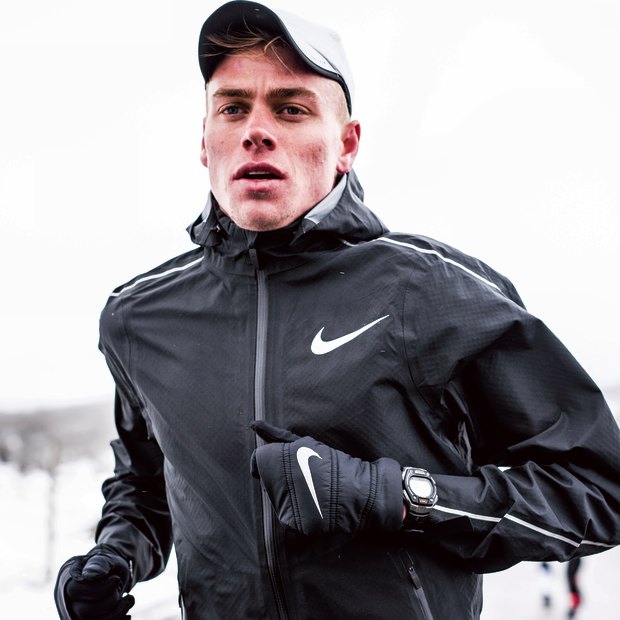
“Stewy doesn’t have to improve that much to win a medal,” says retired distance dynamo Craig Mottram of Stewart McSweyn. “He just has to be at his best. And if he’s at his best, well, shit, I wouldn’t want to race him.”Credit: Riley Wolff
Stewart McSweyn is striking when he runs. And that makes sense, for greatness is striking, so it tends to look that way, too. Running itself is universal, of course – elemental even – yet the gait, rhythm and stride of champions is often as unique as the furrows and ridges of a fingerprint. The legendary Australian miler John Landy, for instance, ran like an ostrich, powerful thigh muscles doing most of the work. His contemporary Ron Clarke strode with focused fury, like an enraged bull. The great Herb Elliott – according to the late great sports writer Harry Gordon – moved more fluidly, like a cheetah, “flowing as if his body weren’t touching the ground”.
For this meditation on McSweyn – a 26-year-old middle-distance phenomenon and Olympic medal chance from King Island – I want a similar zoomorphic comparison. I want him to dart with the twitchy propulsion of an antelope. Or gallop like a gallant thoroughbred, surging at his own urging. But what do I see while studying him, racing and training in suburban Melbourne? What does the skinny mid-career runner look like doing track work in Glen Waverley or tempo running on lush grass at Caulfield Racecourse or gravelly hill climbs in Wattle Park?
He looks awkward. Stilted and jerky. Robotic even. His head juts forward disconcertingly. He bounds on his toes. His ankles barely flex and his heels scarcely touch the ground. He looks in truth as though he might trip over at any given moment. Countless online forums are devoted to running mechanics – where boffins argue over hip activation and trunk counter rotation, or whether it’s better to land mid-foot or fore-foot – but as retired athletics commentator Bruce McAvaney notes, it doesn’t really matter. “The sprinter Michael Johnson sat strangely bolt upright when he ran,” McAvaney says. “The great Emil Zatopek looked like he was dying in pain every 10 metres. Not every star can look as beautiful as Carl Lewis.”
Brett Robinson, Australia’s champion half-marathon runner and a training partner to McSweyn, analyses the technique. “Stewy’s got no knee drive; he’s all bum kick,” Robinson says. “And he’s got no flexibility whatsoever. If you asked him to touch his toes, he would be 30 centimetres away from reaching.” His coach, the peerless Nic Bideau (who guided Cathy Freeman to a gold medal in 2000), says the stiffness is what sets McSweyn apart. It’s efficient.
“When other guys hit the track, a lot of the force they’re generating gets
absorbed,” Bideau says. “But this guy – the way he runs? – all that force is given back to him. It’s like he’s Oscar Pistorius, with carbon fibre legs. Or springs.”
It calls to mind the coach and runner from the opening and closing scenes of the film Gallipoli.
“What are your legs?” Springs. Steel springs.
“What are they gonna do?” Hurl me down the track.
“How fast can you run?” As fast as a leopard.
“How fast are you gonna run?” As fast as a leopard!
“Then let’s see you do it!”
The sweet protagonist of that film actually reminds me of McSweyn. They have the same innocent manner and floppy blond hair, jaunty grin and gaunt cheekbones; even the occasional pimple and pockmark of youth. McSweyn is tall (190 centimetres) and light (71 kilograms), a late bloomer only now growing into his body and ability. And in the past 18 months, this young man in a hurry has been on an almighty tear.
In December 2019, he broke the Australian record for the 10,000 metres (27:23.80). Then on September 17, 2020, he broke the Australian record for the 3000 metres (7:28.02). A week later, on September 25, 2020, he broke the Australian record for the 1500 metres (3:30.51).
Remember the magical four-minute mile? Six months ago, on a windy little track in Penguin, Tasmania, he ran it in 3 minutes and 50 seconds: the fastest mile ever recorded on Australian soil. McSweyn is swiftly becoming one of the greatest Australian male track athletes of all time.
“He’s already almost there,” says champion marathon runner Steve Moneghetti. “Not yet in medals won, but certainly times run.”
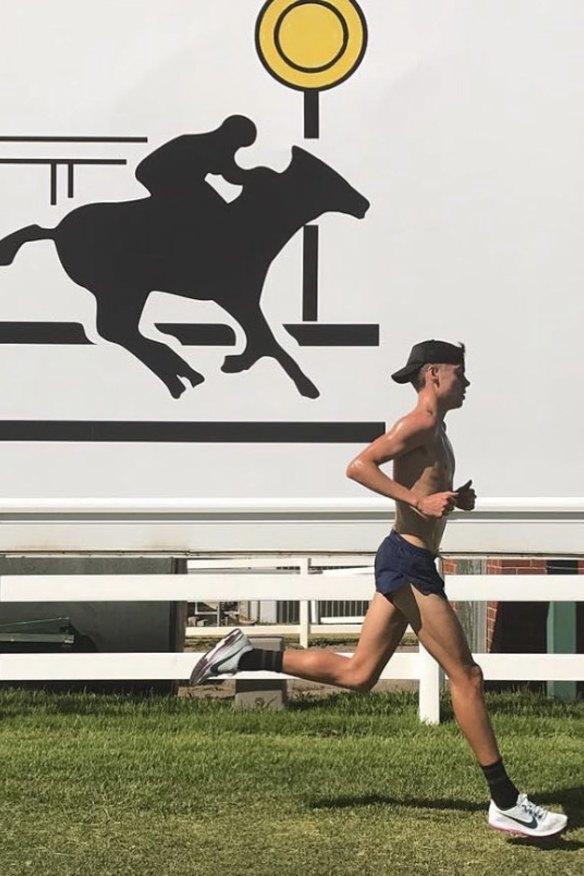
McSweyn training at Caulfield Racecourse, which he does every Tuesday morning.Credit: Courtesy of Stewart McSweyn
Yet here’s the thing: I’m fairly certain most of you have never heard of Stewart McSweyn. He remains unfamiliar even to some sports scribes, like the writer who penned a piece about one of his blistering recent races with the headline: “Maxwayne’s [sic] Ferocious 3200 Metres Run in Stawell.” Such indignities would not befall Cameron Monster [sic] or Buddy Frecklin [sic] or Tim Peine [sic], but that’s more an indictment of the withering public profile of athletics (more on that later) than this particular athlete.
The Taswegian has done his bit, coasting to qualification for the Tokyo Olympics in the 1500, 5000 and 10,000 metres: three events with dizzying competitive depth. Most mortals focus on one distance to the exclusion of all others, because the energy systems and training are so specific. “But Stewy has crossed that,” notes Moneghetti. “He hasn’t had to choose.”
His range is amazing. Almost unprecedented. The (running) world waits to see what he can do with it on the greatest stage. Retired distance dynamo Craig Mottram once said running success “comes down to the size of your balls”: in your willingness to lead, and hold, and endure. That’s what he expects McSweyn to showcase next month in Japan. “Stewy doesn’t have to improve that much to win a medal,” Mottram muses. “He just has to be at his best. And if he’s at his best, well, shit, I wouldn’t want to race him.”
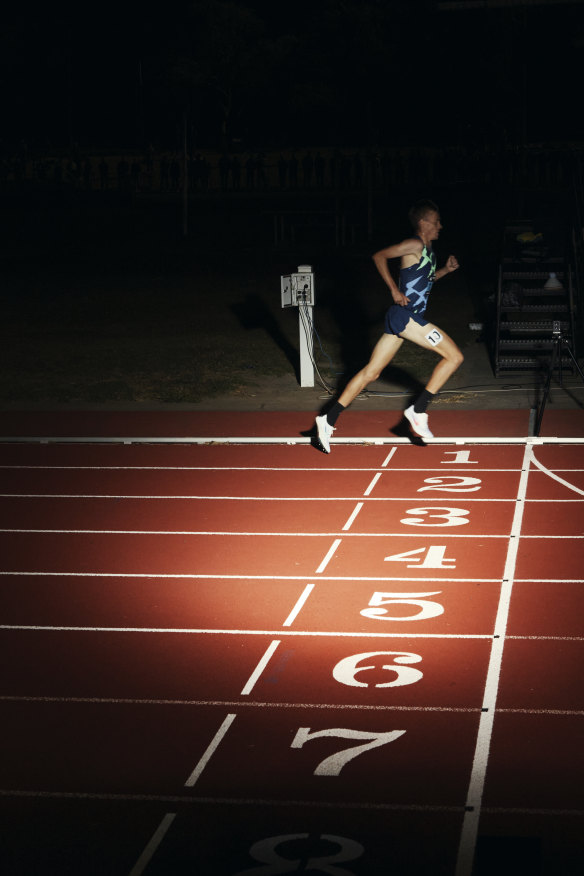
McSweyn competes in the Box Hill Burn in Melbourne in March this year.Credit: Kristoffer Paulsen
I meet Mum and Dad McSweyn – Jacky and Scott – on Easter Monday at the famous Stawell Gift. Their boy is stretching on the spongy oval in western Victoria, warming up for the 3200 metres where he’s the scratch marker, starting at the rear of the field. He storms home to finish fourth, unable to reel in the massive head start given to the field, yet it’s scintillating to see him gobble up the grass while trying.
This rural land, three hours west of Melbourne, is not unlike King Island, where McSweyn grew up on 600 undulating hectares for 500 head of Black Angus cattle, and where vicious Antarctic southerlies fly off Bass Strait, keeping the wool fibre clean on 4000 head of Merino sheep. Farm life meant drenching sheep, marking calves, getting around the herd on motorbike or ute, and, during shearing season, sorting clean woollen curls from those covered in shit. It meant nights bagging sheep poo to sell to little old ladies.
“Slave labour,” Jacky says with a flat smile. “No early mornings though. The weather is never good enough there to get work done until the day
progresses a bit.”
McSweyn has a little sister, Carmen, and a twin brother, Gus – younger by 10 minutes – and they had limitless space to kick the Sherrin and belt cricket balls. They liked golf, too, and used a ride-on mower to trim tee boxes and greens into the hay paddocks. Gus apparently had more sporting talent, but Stew had drive. Take community tennis matches. “His brother had fantastic trick shots, but Stew just ground people into the court,” says Scott. “The person who took the lessons said it was like playing against a brick wall.”
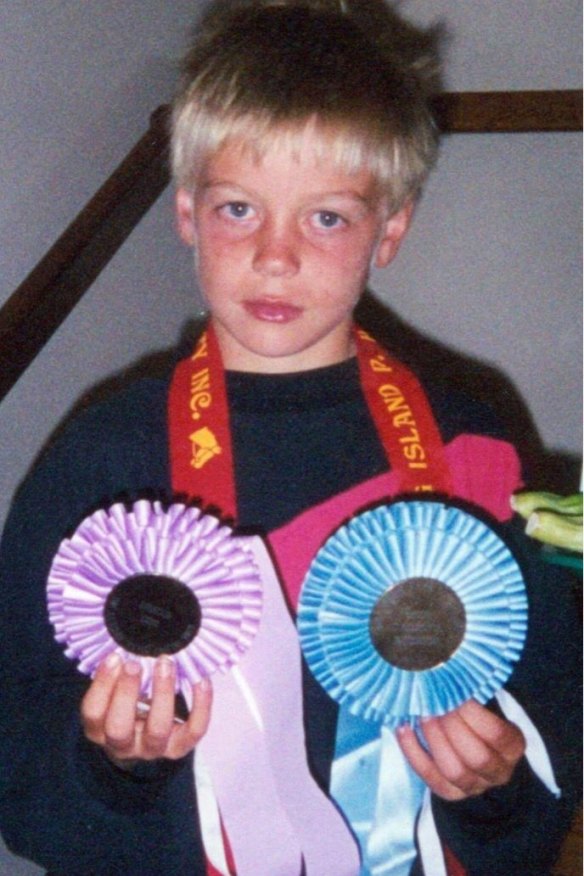
McSweyn at the King Island Show, holding his winning ribbons for a fun run and horse riding competition.Credit: Courtesy of Stewart McSweyn
Running was an afterthought. McSweyn ran his first cross country race in grade 5, wearing old Dunlop Volleys. He won, went to a competition on the north-west coast of Tasmania, and finished second. Coaxed into training a little during lunchtimes, he returned in grade 6 and won by a lap. His coach stroked his chin and murmured: “I don’t think you’re too bad at this.”
McSweyn was small, however, and struggled in his teen years against muscular post-pubescents. He had asthma, too, which flared at his first junior world cross country championship in Bydgoszcz, Poland. “It was minus 7 degrees, and people were skiing around the running track,” says Jacky. “He ran, but he couldn’t breathe properly and struggled the whole way.”
I wonder if he liked running then, or if he even likes it now? “Ummm … I like competing and travelling around,” McSweyn offers. “I guess you’re always testing yourself. Whatever you put in, you get back. I like that part.” He got better, improving throughout high school as a boarder at Ballarat Clarendon College in Victoria, but was no standout, perennially finishing in second place. His action needed correcting. His step had bounce, and bounce is wasteful. Heavy training changes that – it flattens you.
“There’s nothing cleverer than your body and its ability to adapt for efficiency,” says Moneghetti. “It doesn’t want to be in the air so long, so you unconsciously begin to scoot across the ground.”
He still needed size, however, and finally got it after high school: a huge growth spurt all in the legs. Suddenly he had enviably long levers, but no strength. “We used to look at him and go, ‘This guy’s gonna get injured if he doesn’t get some muscle on him’, ” says Bideau, who began coaching him in 2016 when he was 21. “He was spindly and weak. A twig, really. He looked like Bambi.”
Bideau, by contrast, is strong and tanned, and has the windblown bearing of a man who spends his days next to running tracks, barking lap splits at genetic lottery winners. Our pre-eminent running coach, he most recently took 11 Aussies to the Rio Olympics. He also operates mostly outside the Athletics Australia tent, where some regard him as a maverick or manipulative svengali. Retired sprinter Raelene Boyle once called him “ruthless” and “controlling” of the pupils at his Melbourne Track Club. “It’s Nic’s way or the highway,” she wrote. “He’s god and they are his flock.” McSweyn, though, says Bideau is tough but fair, and affords great autonomy: a partner, not a boss, and certainly not a god. His first challenge was making McSweyn feel comfortable in elite company, but even that was difficult. “I remember looking at these top guys thinking, ‘How do they do that?’ ” McSweyn says. “They were like aliens to me.”
Belief began to gather in trickles. In 2017 he started racing in Europe, hanging around those aliens at the hotel, visiting the Nike hospitality suite, glimpsing a new galaxy of competition and travel. “All his junior life, he didn’t really win, didn’t expect to win, and was quite happy to run well or just be thereabouts,” says Bideau. “We used to take him to races and wonder ‘What the f… is he doing? Why doesn’t he get rid of these blokes?’ He was letting them run with him when he should have been killing them.”
Slowly, McSweyn came to see the havoc he could wreak with his ability to maintain speed for laps at a time. He also began to inhabit the ascetic devotion required. Neither garrulous nor loose, abstention suited him. McSweyn is serious about running, says Moneghetti, but not so much about himself. “He’s actually a bit of a dag. You wouldn’t meet Stew and say, ‘That’s the future of Australian distance running.’ ”
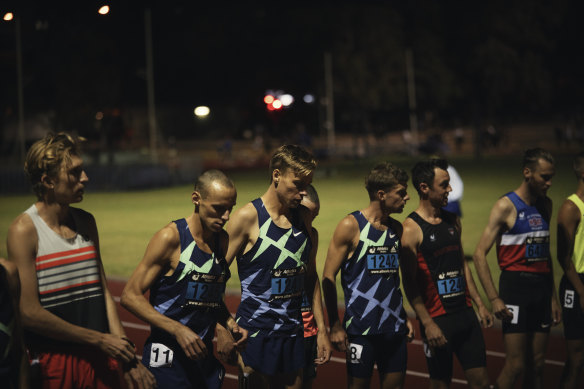
McSweyn (third from left) with a number of international-calibre 5000-metre runners at the start of the Box Hill Burn; he eventually leaves them all in his wake. Credit: Kristoffer Paulsen
There was a time, a time most would not recall, when running was big in this country – when Landy and Clarke and Elliott were figures in the daily sporting firmament. But that time has passed, and so the great running feats of today pass mostly without mention.
“Runners are hidden in the background,” says Bideau. “But Stewy McSweyn is a different breed. He’s like a Black Caviar or a Ricky Ponting or a Dustin Martin. He’s exceptional, and people like to see that, but they don’t know about him, so they don’t get the chance.”
Brett Robinson is only 30, and remembers marvelling in his youth at the swollen, lively crowds turning out for the Australian Track & Field Championships. Just a few weeks ago, he was crestfallen at the same event: “There weren’t even 200 people watching,” he says. “It does suck. It does.”
It comes down to winning. Since 1968, Australia has only had one male individual Olympic running medal: the late Rick Mitchell taking silver in Moscow in 1980. In order to steal any attention from AFL, NRL and cricket – not to mention the burgeoning women’s leagues for each sport – more such medals are required. And for McSweyn to become a household name? He has to win, says retired champion marathon runner Robert de Castella. “And then you’ve got to win again, and again,” he adds. “You’ve got to deliver to expectations, and reward the public. They can be pretty cruel if they’ve got up to watch you in the middle of the night and you disappoint them.”
The main cohort keeping Australians (or anyone, really) from victory is the long-dominant East African bloc. Experts often muse about the potential genetic factors at play – thin, tapered calves and a lifetime running at altitude – but others suggest the imposing medal count of Kenya and Tanzania, Ethiopia and Uganda, is a function of volume. In the Great Rift Valley, running is a pathway out of poverty, and a part of life, while the best runners in the Western world are likely hidden in plain sight, chasing balls around green fields.
That may be changing. The American college system is producing endurance animals again. Europe is joining in, too, bolstered by one of McSweyn’s biggest obstacles, the prodigious Jakob Ingebrigtsen. (You can check out his exploits – along with big brothers Henrik and Filip, and father Gjert, their coach – on the reality show Team Ingebrigtsen, a ratings smash in Norway since it premiered in 2016.) Mottram, the man who was once given the Swahili nickname “Big Mazungo” (meaning “big white man”), says pale runners are steadily finding their way back into races recently dominated by wiry black bodies. “Athletes from outside of Africa have that belief that they can compete again,” he says. “A door has been opened.”
Running is also a spectator sport again, at least abroad. In the high-profile Diamond League – a global series of invitational track and field competitions – McSweyn is used to running in front of heaving crowds, from 55,000 at King Baudouin Stadium in Brussels, to brimming boutique arenas like Stade Louis II in Monaco. He can take home $US10,000 ($13,000) for a single race, not to mention $US50,000 if he wins that event for the season. That’s how he makes his living. McSweyn is sponsored by Nike, and supported by the Tasmanian Institute of Sport and Athletics Australia, but flights and accommodation are expensive. Total pay packet? “It would probably be less than your average AFL player, but more than your average teacher,” he says. “I’m not going to be set up for life.”
Indeed, he buzzes around Melbourne in a white 2010 Hyundai Getz, a decade-old economy hatchback into which he barely fits. (If you want to pick one up, there are four for sale at carsguide.com.au for about $1900 each.) It’s actually his mum’s car. She used to leave it in Melbourne to drive when visiting the mainland, instead of paying for a rental. “Not a great car, but it’s free,” he says. “Only $40 to fill it up. A car’s a car.”
A room is a room, too, apparently. The spartan McSweyn lives in a tiny second-storey apartment in St Kilda East which he shares with his sister.
“She’s the reason the place is in good nick and has a bit of style,” he says, sitting at a coffee table laden with fashion books by Lauren Conrad and Marie Claire. His lone items in the combined kitchenette-lounge area are the Nespresso machine, a massive cylindrical tub of protein powder and the John Landy Award he was just given for being the best male athlete in Australia last year: basically the Brownlow or Dally M for runners.
This is where he studies in his spare time. McSweyn is halfway through an education degree at Deakin University, which he hopes will lead to a career as a high school English and PE teacher. He recently did a placement in a disadvantaged area of Melbourne, at Dandenong High School. “But I’d love to work at a school where they have an athletics and track program, and coach the school team,” he says. “At some point I’ll have to get a real man’s job.”
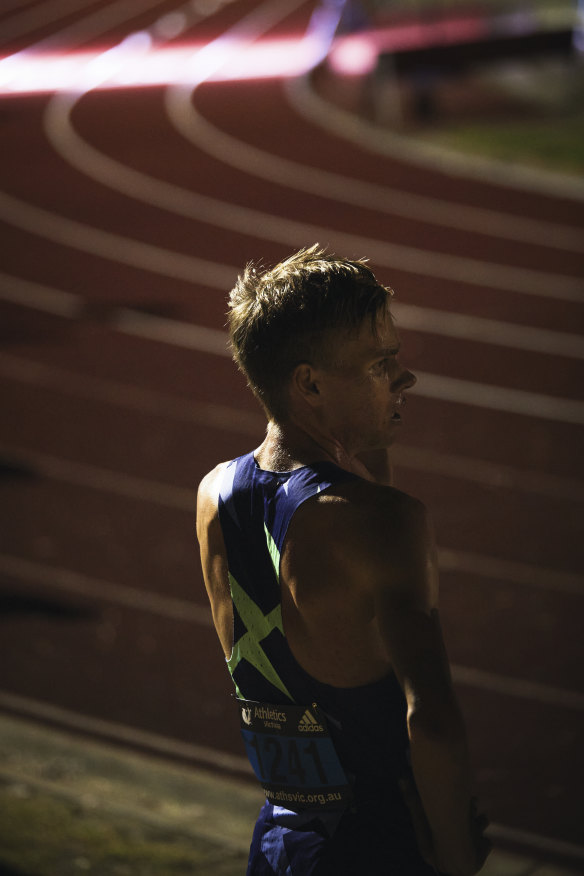
Warming down after a race, McSweyn takes a breather alone.Credit: Kristoffer Paulsen
If you find running boring, I understand. Boringness is literally built into the lexicon of the sport, with training programs designed to achieve optimal “training monotony”: a metric for repetitive workloads that are physically effective without being psychologically destructive. McSweyn runs a seemingly endless road in training, too, covering roughly 160 kilometres a week, enough each year to run across Australia and back. I like to imagine him as an antipodean Forrest Gump: a desert runner starting in Steep Point, WA, jogging east across the Gibson and the Simpson, bound for Byron Bay, before turning around and chasing the sunset back along the same infinite path. It’s no surprise that he wears out the cushion on a pair of Nike Pegasus every few weeks.
Yet it’s not as enervating as it might sound. It’s almost meditative. The writer Haruki Murakami – an avid runner – says that he runs not just within a void but rather to attain a void. “The thoughts that occur to me while I’m running are like clouds in the sky. Clouds of all different sizes,” he writes. “They come and they go, while the sky remains the same sky as always. The clouds are mere guests in the sky that pass away and vanish, leaving behind the sky.”
The same transcendental drift is felt by McSweyn, whose legs wander while his mind does, too, evaluating his today or planning his tomorrow. “For me, the busy world we live in kind of stops,” he says. “But it never disappears, either.”
If anything, his fuel intake seems more arduous. Take a standard day. A big bowl of muesli and a few glasses of water with a hydration tablet, then coffee and a banana before training. Afterwards, a protein shake. Home again for more cereal, Weet-Bix. For lunch, maybe a sandwich, rice and tuna. An afternoon session of running demands another protein shake. Dinner is vegetables and salad, with steak, maybe some home-cooked potato chips. Late at night another snack, some fruit and a bowl of Special K. Before bed, some peanut butter toast and a juicy plum. Oh, and at least three litres of water throughout.
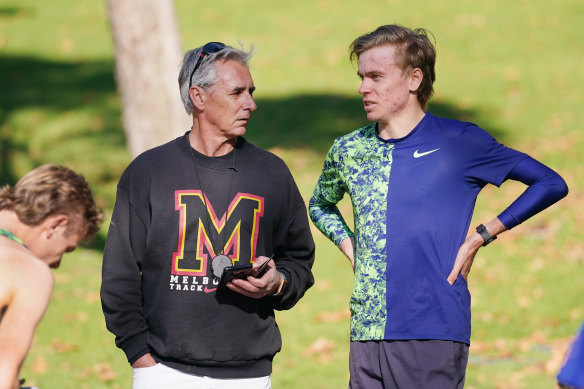
As long as McSweyn’s training is “comfortably hard”, it will be enough says coach Nic Bideau: “He’s already a diamond; you don’t have to smash him to smithereens to prove it.”Credit: AP
The gym is essential, too, although not for muscle but stability: making sure he’s strong enough to withstand a bruising training regimen, and to redress the imbalance created by focusing so singularly on one muscle group. One bad sprain or tear can have a disastrous cascading effect, so McSweyn is famously protective of his body. He doesn’t like sprinting in training, for instance, fearing a hamstring tweak. Bideau doesn’t feel compelled to argue. “It’s not about me, writing down a nice rep in my book and admiring it later,” he says. “That really fast training can flatten some guys. Instead of getting better, he’ll just get tired.”
This isn’t a revolutionary view, but nor would it be tolerated by all others, certainly not in the past. The late coaching mystic Percy Cerutty – described variously as a genius, braggart and crackpot – built up his runners on the “Stotan” philosophy of success through pain. Bideau shrugs. As long as McSweyn’s training is “comfortably hard”, it will be enough: “He’s already a diamond; you don’t have to smash him to smithereens to prove it.”
This window is crucial. McSweyn is 26. The Olympics are next month, the World Championships next year, as well as the Commonwealth Games in Birmingham. The Paris Olympic Games are only three years away. Health is the key not just to short-term success but to successful longevity. His trajectory depends on how many years of uninterrupted quality training he can amass.
“Ninety-nine per cent of what we do is the same as the previous year,” explains his training partner and mate, Jordie Williamsz. “If you can keep going and not let anything slip, you’ll get a little more out of that remaining 1 per cent every year. It’s elegant – this constant refinement of one thing.”
So the training itself is what McSweyn thinks about throughout any race. He channels memories of work. Of the biting cold on a snowy road in Falls Creek. Of grimy backstreets in industrial Ostrava, in the Czech Republic. Of the beach in Rabat, on the Moroccan coastline. Of the view in Paris, where he stays by the Eiffel Tower and jogs along the River Seine. Of the people and bikes in smoggy Shanghai, all dodging a tall skinny Westerner as he does dutiful laps of a gargantuan soccer facility.
And sometimes his mind goes home to King Island, running west through rolling paddocks to the pier at Naracoopa Beach. “You feel like you’re breathing no fresher air in the world. It’s so crisp,” he says. “When you’re racing, you can’t think about the reward, or winning, or a personal best. I think about the training.”
It is a predictably dull thing for athletes and coaches to talk about the sport they love as though each contest of physical prowess is somehow a game of chess. Athletics is no exception. The saving grace, however, is that, in distance running, this is (grudgingly) somewhat true. Record attempts have nothing in common with handicap events, pacing is not chasing, and heats require different strategies than finals. The latter, says McSweyn, can be deeply psychological. See an opponent gaining? “Dig in and try to pull away.” See an opponent struggling? “Go hard on the next bend and see if you can drop ’em,” McSweyn advises. “You can break people in different ways.”
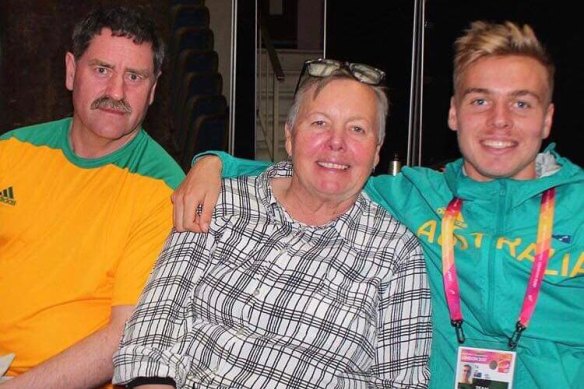
McSweyn with his mother Jacky and father Scott at the Australian embassy in London during his first World Championships in 2017.Credit: Courtesy of Stewart McSweyn
Runners are forced to compute a constant calculus, then commit. If the pace is slow: should you stick with the shuffling pack, or try to break free? If the race is swift with an early leader: do you go with them, or hope they blow up? McSweyn likes to drive hard, daring the rest to follow.
“He tests people, mentally,” Robinson says. “He makes you ask these questions of yourself: I shouldn’t keep going with him, right? Or should I?” The wrong choice might cost you a medal. The 1500 metres, for instance, is notorious among Olympic events for dramatic finishes and shock upsets.
In Tokyo, the top seed will be Kenya’s world champion Timothy Cheruiyot, who has run the distance in 3:28.41: two seconds faster than McSweyn’s personal best. “I think he’s won, like, 93 per cent of all the 1500-metre races he’s entered since 2017,” McSweyn says. “He has a better chance of winning an international 1500 metres than Steph Curry has of hitting a free throw. ‘TC’ is a beast.”
And yet. Such favourites flounder with surprising regularity. The Olympics in Rio produced the greatest surprise of all, when American Matthew Centrowitz jnr won gold, in the slowest-run final since 1932. No one wanted the responsibility of leading, so the race became a raffle, won in a baffling and chaotic final lap sprint. Basically, McSweyn could easily medal next month, and just as easily miss the final, based on the choices he makes.
There are little things he can work on, of course. He doesn’t start well, and spends most first laps trying to get where he wants to be. “I haven’t seen him shove anyone out of the way on the track,” says Williamsz. “Maybe that’s something he needs to look at: asserting some dominance.”
Robinson’s not so sure. He mentions the documentary The Last Dance, and how Michael Jordan found motivation in imaginary conflicts. (“I hate that guy,” Jordan would mutter, sometimes without reason. “I just want to go and beat his ass.″) Jordan created fake feuds, to use as fuel. “Stewy does that now,” says Robinson. “He makes up these little rivalries in his head.”
That edge helps. Win or lose, the goal in racing is to push yourself to your absolute limit, hitting that finishing line at the exact moment the body feels defeated, exhausted, spent. The process unfolds in painful increments. McSweyn notices his form collapsing first, then the lactic acid builds in his legs. With lungs aflame, his focus wavers. “All that stuff connects,” he says. “The trick is not letting everything crumble at the same time.”
His coach calls this an “ability to hurt”. “Anyone can suffer, they all do in training,” says Bideau. “But when they’re in pain, some guys fold with one move. When people try to get rid of Stewy, they’ll have to try again and again and again. He suffers, but his mind stays in the game.”
The silence of an empty stadium – the brand new $2 billion Japan National Stadium in Shinjuku City – is unlikely to spook him, either. Once the gun goes, he never really thinks about the noise anyway. He thinks about the plan. That varies depending on the competition, of course, and the distance, but McSweyn is unlikely to prevail with a winning “kick”. He’ll have to make his move far sooner than the final lap.
“It’s gotta be the long run for home,” McAvaney assumes. “And if he makes a move into position, he’s got to make sure that move is confirmed. I’ve seen too many runners get themselves into a strong position, then give it up when other moves are made. He cannot concede to anyone.”
This is his time. For memories of training to meet dreams of winning. For the solitude of the empty road to give way to the imagined lonely splendour of crossing the line first. When McSweyn walks onto the track, his Dragonfly spikes gripping that rubber crumb, he will know that what has gone before has no meaning – and that the fate in front of him depends on how many men he leaves behind.
“Once I’m standing on that starting line, I can live with the result as long as I’ve given every bit of myself. All I have to do is execute,” he says. “I’ll be thinking, ‘I’m as good as these guys. I want to be here. I’m ready.’”
To read more from Good Weekend magazine, visit our page at The Sydney Morning Herald, The Age and Brisbane Times.
The best of Good Weekend delivered to your inbox every Saturday morning. Sign up here.